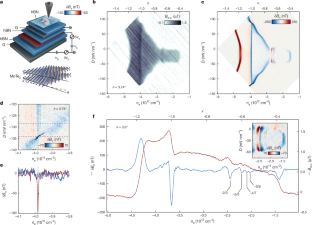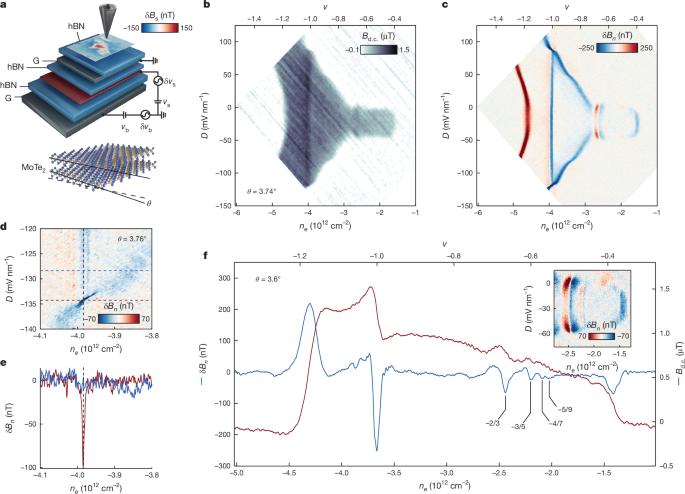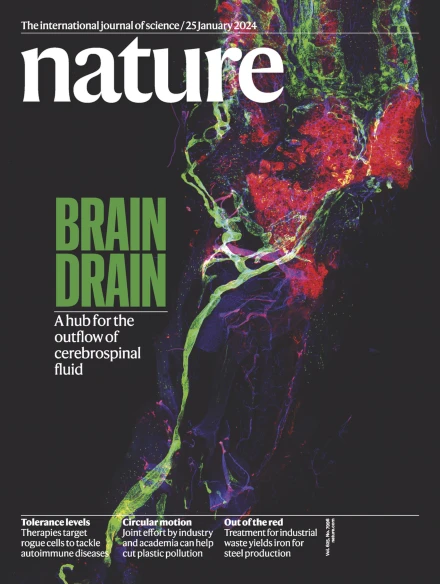Direct magnetic imaging of fractional Chern insulators in twisted MoTe2
IF 50.5
1区 综合性期刊
Q1 MULTIDISCIPLINARY SCIENCES
引用次数: 0
Abstract
Orbital magnetization provides a sensitive probe of topology and interactions, with particularly rich phenomenology in Chern insulators in which the topological edge states carry large equilibrium currents. Here we use a nanoscale superconducting sensor1,2 to map the magnetic fringe fields in twisted bilayers of MoTe2, in which transport3,4 and optical sensing5,6 experiments have revealed the formation of fractional Chern insulator (FCI) states at zero magnetic field. We observe oscillations in the local magnetic field associated with fillings ν = −1, −2/3, −3/5, −4/7 and −5/9 of the first moiré hole band, consistent with the formation of FCIs at these fillings. We determine the local thermodynamic gaps of the most robust FCI state at ν = −2/3, finding −2/3Δ as large as 7 meV. We also characterize sample spatial disorder, which is dominated by both inhomogeneity in the effective unit cell area7 as well as inhomogeneity in the band edge offset and bound dipole moment. Our results highlight both the challenges posed by structural disorder in the study of twisted homobilayer moiré systems and the opportunities afforded by the robust nature of the underlying correlated topological states. A nanoscale superconducting sensor used to map the magnetic fringe fields in twisted bilayers of MoTe2 shows the formation of fractional Chern insulator states at zero magnetic field.


扭曲 MoTe2 中分数切尔绝缘体的直接磁成像
轨道磁化是拓扑和相互作用的灵敏探针,在拓扑边缘态携带大平衡电流的切尔绝缘体中,轨道磁化现象尤其丰富。在这里,我们使用纳米级超导传感器1,2 来绘制 MoTe2 扭曲双层膜中的磁边缘场,其中的传输3,4 和光学传感5,6 实验揭示了零磁场下分数切尔绝缘体(FCI)态的形成。我们观察到与第一莫伊里孔带的填充ν = -1、-2/3、-3/5、-4/7 和 -5/9相关的局部磁场振荡,这与在这些填充处形成的 FCI 相一致。我们确定了ν = -2/3处最稳健的FCI态的局部热力学间隙,发现-2/3Δ大至7 meV。我们还描述了样品的空间无序性,其主要原因是有效单位晶胞面积7 的不均匀性以及带边偏移和束缚偶极矩的不均匀性。我们的研究结果既凸显了结构无序给扭曲同层摩尔系统研究带来的挑战,也显示了底层相关拓扑状态的稳健性所带来的机遇。
本文章由计算机程序翻译,如有差异,请以英文原文为准。
求助全文
约1分钟内获得全文
求助全文
来源期刊

Nature
综合性期刊-综合性期刊
CiteScore
90.00
自引率
1.20%
发文量
3652
审稿时长
3 months
期刊介绍:
Nature is a prestigious international journal that publishes peer-reviewed research in various scientific and technological fields. The selection of articles is based on criteria such as originality, importance, interdisciplinary relevance, timeliness, accessibility, elegance, and surprising conclusions. In addition to showcasing significant scientific advances, Nature delivers rapid, authoritative, insightful news, and interpretation of current and upcoming trends impacting science, scientists, and the broader public. The journal serves a dual purpose: firstly, to promptly share noteworthy scientific advances and foster discussions among scientists, and secondly, to ensure the swift dissemination of scientific results globally, emphasizing their significance for knowledge, culture, and daily life.
 求助内容:
求助内容: 应助结果提醒方式:
应助结果提醒方式:


